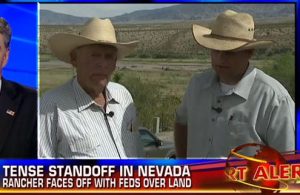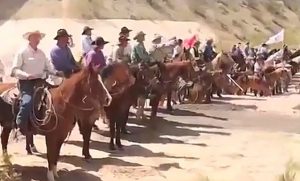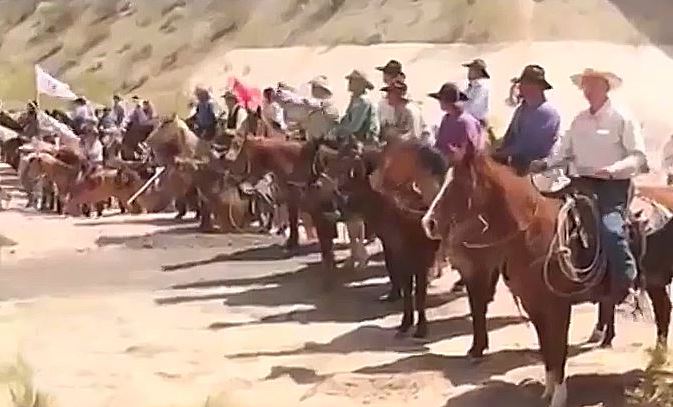In January 2016, an armed militia group seized control of the Malheur National Wildlife Refuge in eastern Oregon. Their goal: to protest federal control over western rangelands. It’s the latest episode in a long history of conflicts over the use of federal lands in the West. Reposted from Free Range Report.
 Introduction
Introduction
For a few short weeks during the spring of 2014, the intricacies of the U.S. federal grazing system garnered national attention. Major newspapers ran front-page stories. Television crews rushed to cover the issue live from the western range. Cable networks broadcast videos of cattle grazing on the evening news. If only for a moment, it seemed as though the entire nation was debating federal grazing policy as a tense standoff unfolded between the Bureau of Land Management and one Nevada rancher named Cliven Bundy.
Mr. Bundy, as the story went, was a scofflaw—a recalcitrant rancher who illegally grazed his cattle on federally owned lands for decades without paying the required federal grazing fees. An outspoken critic of the BLM, Bundy refused to acknowledge the federal agency’s authority over the land outside Bunkerville, Nevada. “As far as I’m concerned, the BLM don’t exist,” he said during a presentation a few months earlier. He had a vested right to graze cattle on the vast rangelands outside of Bunkerville, he said, just as his family had for generations.1
“When I decided that I was paying grazing fees for somebody to manage me out of business, I said, ‘Hell no,’” Bundy told the audience in a presentation in February 2014. “And what did I tell them? I no longer need your service as a manager over my ranch, and I’m not going to pay you for that no more.”
The BLM, however, disagreed, and in April 2014 the agency began rounding up hundreds of Bundy’s cattle from the federal rangeland. The agency claimed that Bundy owed nearly $1 million in unpaid grazing fees and fines. The cattle were not only trespassing; they were trampling sensitive habitat for the desert tortoise, a federally protected species. The BLM dispatched hundreds of federal agents along with contract cowboys and helicopters to descend upon the Nevada desert to capture, impound, and remove Bundy’s cattle from federal land.2 When Bundy refused to back down, the situation escalated quickly. Dozens of anti-government activists rallied in support of Bundy to stop the roundup and fight back against the BLM.
To many observers in the East, the roundup was seen as a clear example of federal overreach. Within a few days, a full-on range war was brewing in Bunkerville. Mobs of angry protesters and armed militiamen confronted BLM agents as they attempted to corral Bundy’s cattle. At one point, guns were drawn. One protestor, one of Bundy’s sons, was shot by federal agents with a stun gun.
The standoff captured the nation’s attention. Almost overnight, Bundy became an icon in conservative media outlets for standing up against an oppressive and powerful federal agency. In other media circles, Bundy was portrayed as a “welfare cowboy” who blatantly disregarded the law and grazed his cattle at the expense of U.S. taxpayers. And to others, he was simply a criminal with a rogue militia gang—a clear indication that the violence and lawlessness of the wild, wild West is still alive and well in the deserts of Nevada.
In the end, the BLM backed down, citing concerns over the safety of their employees and the public. The cattle were released back on to the federal rangeland, where they remain today. The range war in Bunkerville gradually defused, and Bundy emerged unscathed. But for Bundy, the limelight did not last for long. A few days later, he was recorded making offhand racist remarks to a journalist and was swiftly denounced by the media. Almost as quickly as it began, the grazing debate—along with Bundy himself—faded from the headlines.

The Rest of the Story
The conflict between Cliven Bundy and the BLM transformed federal grazing policy into a salient political issue in the minds of many Americans, if only for a brief time. Bundy’s story, however, is far more complicated than it was portrayed on national television. The narrative that emerged in the media implied that the conflict was straightforward: A rancher refused to pay his grazing fees and, as a result, was nearly evicted from the land.
But in fact, the standoff on the Bundy ranch was the product of a longstanding confrontation between ranchers and environmental groups over the nature and security of federal grazing rights in the United States. That debate is embedded within the unique and complex history of U.S. grazing policy. It’s a story that illustrates one of the central challenges facing grazing policy today: how to resolve conflicting demands on the federal rangeland in an era of new and competing environmental values.
Consider the more nuanced version of Bundy’s dispute: For generations, Bundy’s family grazed cattle on the vast rangelands of the western United States. Like many ranchers in the West, Bundy had a federal grazing permit, issued by the BLM, which authorized him to graze a certain number of cattle on the 160,000-acre Bunkerville Allotment in southeastern Nevada. The federal grazing system requires that grazing permittees must own certain private properties that are legally recognized by the federal government as qualifying for federal grazing privileges.3 In this case, Bundy’s right to graze cattle on federal land was dependent upon his ownership of a 160-acre parcel located in Bunkerville, Nevada.4 In effect, his grazing permit was attached to this particular “base property.” Along with the ranch, Bundy also secured groundwater rights, which together with the base property enabled him to secure and maintain grazing privileges to the Bunkerville Allotment. The value of Bundy’s property was enhanced by and dependent upon the public grazing privileges it provided to the nearby allotment.
For years, Bundy grazed his cattle on the federal grazing allotment and paid the required grazing fees—which typically amounted to approximately $1.35 per animal unit month (AUM).5 But in 1993 the federal government made an adjustment to Bundy’s grazing permit. Under pressure from environmental groups, the agency significantly reduced the number of cattle that Bundy was authorized to graze on the allotment in an effort to protect desert tortoises, a species that had recently been declared as threatened by the U.S. Fish and Wildlife Service. This modification had a significant effect on Bundy’s cattle operation as well as the value of his base property. Because Bundy’s ranch came with federal grazing privileges, reductions to his grazing permit could cause a corresponding reduction in his base property value. And with just 160 acres of deeded private land—nowhere near the amount necessary to sustain a cattle herd in the arid West—reductions such as this could threaten Bundy’s future livelihood as a cattle rancher.6
Bundy refused to accept the BLM’s modified grazing permit and continued grazing his cattle on the Bunkerville Allotment. He also refused to pay the grazing fees and trespass fines levied against him. In 1994, the BLM formally revoked his grazing privileges for “knowingly and willfully grazing livestock without an authorized permit,” setting in motion Bundy’s decades-long battle with the BLM.7 After several court orders to remove the cattle and ban Bundy from grazing on public lands—in addition to nearly $1 million in grazing fees and fines owed by Bundy—the conflict finally reached a boiling point in April 2014 when the federal government began to roundup the trespassing cattle.
Bundy’s story is not unique. Ranchers across the West increasingly face similar challenges to their traditional grazing use of the federal rangeland. This has contributed in part to a general decline in grazing on federal rangelands and a perception among many ranchers that their future is threatened by the emergence of environmental regulations.8Today, the amount of grazing authorized on BLM land is half of what it was in 1954.9 Bundy’s case is simply the most salient and well-documented dispute in recent years.

This more nuanced story illustrates the central challenge explored in this essay: In the United States, grazing conflicts such as Bundy’s are born out of a federal grazing system that encourages conflict, not negotiation. Competing user groups often have no way of coming together to resolve conflicting demands except through top-down political or judicial means. Environmentalists, for their part, frequently file legal challenges over land management, forcing federal land agencies to restrict grazing rights and declare more areas off limits to grazing and other historic land uses. Environmental statutes such as the Endangered Species Act and National Environmental Policy Act (NEPA) serve as regulatory weapons to reduce the impacts of grazing on federal lands, undermining the traditional grazing rights. The result is a federal land system strangled by what former U.S. Forest Service chief Jack Ward Thomas described as a “Gordian knot” of litigation and regulation.10
The problem of the “Gordian knot” is intensified by the vast reach of the federal government’s authority over western lands in general and over western livestock grazing in particular. Federal agencies control nearly half of the land in the western United States, including more than 60 percent of Idaho, 67 percent of Utah, and more than 80 percent of Nevada.11 As a result, livestock grazing in the West is a federal land issue in many cases. Due to the relatively small amounts of private land in the West, along with the region’s arid conditions, which require large amounts of land to sustain livestock operations, western ranchers have relied on access to federal land for forage resources for more than a century.
Today, the BLM administers nearly 18,000 grazing permits and manages more than 21,000 grazing allotments on 155 million acres of public lands managed for livestock grazing.12 The U.S. Forest Service also administers a federal grazing program in the agency’s national forests and grasslands, comprising more than 95 million acres of land with nearly 6,000 permittees.13 In 2013, together, these agencies provided 15 million AUMs worth of forage resources for livestock grazing, or enough forage to feed 15 million cow-calf pairs or 75 million sheep or goats for a month.
Federal control over grazing in the American West means that debates over who gets to do what on the land are ultimately determined through political or legal processes rather than a market process. As a result, disputes are ridden with acrimony, litigation, and in some cases even violence or intimidation. In 1997, when the BLM proposed to significantly reduce public land grazing in Owyhee County, Idaho, the local sheriff threatened to throw federal agents in jail if they enforced the reductions.14 Prior to the standoff on Bundy’s ranch, Nevada ranchers had repeatedly resorted to violence and intimidation to resist similar grazing restrictions. Environmentalists have even sabotaged grazing operations by cutting barbed-wire fences and otherwise disrupting public land grazing practices.15
This essay examines the U.S. federal grazing system and explores its ability—or its inability—to resolve competing demands through negotiation rather than conflict. Federal grazing policies in the United States have largely proven unable to reconcile conflicting demands on the western range. In many cases, existing policies may even exacerbate the problem. The central issue, this essay will argue, is the security and transferability of property rights to rangeland resources. In particular, conflicts over grazing on federal lands are the product of poorly defined grazing rights and restrictions on the transferability of grazing permits. Environmental groups and other competing user groups effectively have no way to bargain with livestock owners to acquire grazing rights. Their ability to trade is prohibited or severely limited under existing federal grazing policies. As a result, federal rangelands are too often the subject of conflict, litigation, or regulation, rather than exchange, negotiation, or cooperation.
In the sections that follow, this essay explores these challenges and identifies key issues and opportunities for reform. It offers a framework for thinking about how grazing conflicts are resolved, borrowing from a theory known as raid or trade, and explores several efforts by conservation groups and private landowners to overcome the barriers to trading rights to the federal rangeland. The essay concludes by exploring the lessons learned from these limited efforts in the United States and discusses how the federal grazing experience might inform rangeland policy in other jurisdictions. In the process, it suggests several opportunities for reforming the U.S. federal grazing policy to promote more sensible, peaceable solutions to conflicts over the western rangeland.
Reposted from Free Range Report.
RANGE / RANGEFIRE! — Addressing Issues Facing the West / Spreading America’s Cowboy Spirit Beyond the Outback
You may also like
-
Omnibus bill provision would “unleash” electronic tracking on nation’s cattle
-
Arizona rancher sues to stop million-acre national monument
-
VDH: How to Destroy the American Legal System
-
Bob West: Facing the reality of wolves, Colorado ranchers need to be prepared
-
Protect The Harvest: The whole truth about Western ranching

